How would you like to...
Increase your revenue from Google Ads by 20% in 30 days?
If you want your Google Ads pumping so your campaigns are producing amazing results in a short amount of time, and you also want longer term gains so you can continue to grow your business revenue over time, then you’ve come to the right place.
Double your revenue from Google Ads within 6-12 months?
In the 15 years that we’ve been running our own Google Ads campaigns over 5 different businesses and providing clients with PPC Management, we’ve pinpointed with precision the 3 phases and 10 steps needed to get short term quick wins and the framework for longer term growth.
Actually spend less and get better results tomorrow?
And we can tell you one thing for free, most PPC Management agencies aren’t doing what we are. We know because we learned the hard way.
 We’ve spent over $1 million!
We’ve spent over $1 million!
Over the years we’ve spent over a million dollars of our own money running our own Google Ads campaigns.
It made us a lot of money, but we’ve also lost a lot along the way. We’ve employed more than 10 PPC management and digital marketing agencies and consultants and sacked them all because they didn’t understand small business. They continually over-promised and under-delivered.
 The result?
The result?
We had to do it ourselves, and so we did. And now we’re bloody good at it!
Great wins, quickly! That's our motto.
Fort Knox Self Storage
Smartpay
Doubled sales in 2 years
Simply for Strings
450% growth in online revenue over 4 years
ARIA Hotels
17 Years of PPC management experience condensed down into the 9 ultimate lessons for success!
Phase 1: 20-50% growth in results in 1-3 months
- Task 1: Bid Management: more of the right visitors with less budget
- Task 2: Budget management and structure: maximise conversions
- Task 3: Search Query Analysis: more of the right visitors and less of the crap
Phase 2: 3-5% growth month on month, year on year
- Task 4: Site Engagement Optimisation
- Task 5: Conversion Optimisation
- Task 6: The Right Tracking & Reporting
- Task 7: Metrics
- Task 8: Integrate Your Software & Systems
A word on our PPC Management philosophy
It sounds straightforward but in a nutshell, when we manage Google Ads campaigns, our focus is on two things.
Firstly, do more of what’s working well
We analyse the Google Ads campaign to determine what you’re doing well. You want to know this so you can do more of it but with better budget management – effectively so you’re spending less to get the same or better results.
Secondly, we fix what’s not performing in your Google Ads campaign
This requires determining which keywords, ad groups, topics or themes or campaigns aren’t producing the results you need them to, and then improve it, fix it, change it. Alternatively, if we’ve done all of that and we still can’t get the results we need, we’ve got to get rid of it. You’ve got to stop doing the things that aren’t working, which is equally important throughout any part of your business.
By following these two steps, you will inevitably start to get lots of really small quick increases to your campaign. It’s the process of getting 2% growth here, 3% there, 1% there, 4% there, so they all add up to really quickly get you 25%, 30%, 50% growth within a matter of a couple of months.
The Power of Compound Interest
“Compound interest is the eighth wonder of the world. He who understands it, earns it … he who doesn’t … pays it.”
Albert Einstein

We apply this rule to the sales and marketing outcomes for our clients that produces compound returns:
- More potential clients to find out about your business
- Better conversions at every touchpoint
- Longer customer relationships
- More repeat customers
Peripheral Factors That Impact Google Ads Results
We’ll talk you through the steps of how to grow your Google Ads results, but before we get started, there are a few pieces to the jigsaw that have an impact on your Google Ads campaigns results.
Only when all of these factors are functioning like a well-oiled machine will you start to reap the rewards.
- Volume – you need lots of visitors (and to get more and more), BUT, they need to be the right visitors.
- Keywords – nailing the right keywords for your campaigns is imperative to attracting the right visitors with a higher intent to purchase your products.
- Shit Hot Website – your website and landing page needs to convert- mediocre or average is just not going to cut it. Your website is one of the best investments you’ll ever make into your business.
- Sales Teams – a sales process and systems to support your sales team to convert more leads to sales.
- Long Term Customer Relationships – customer engagement strategies to build long term relationships with customers and bring them back again and again.
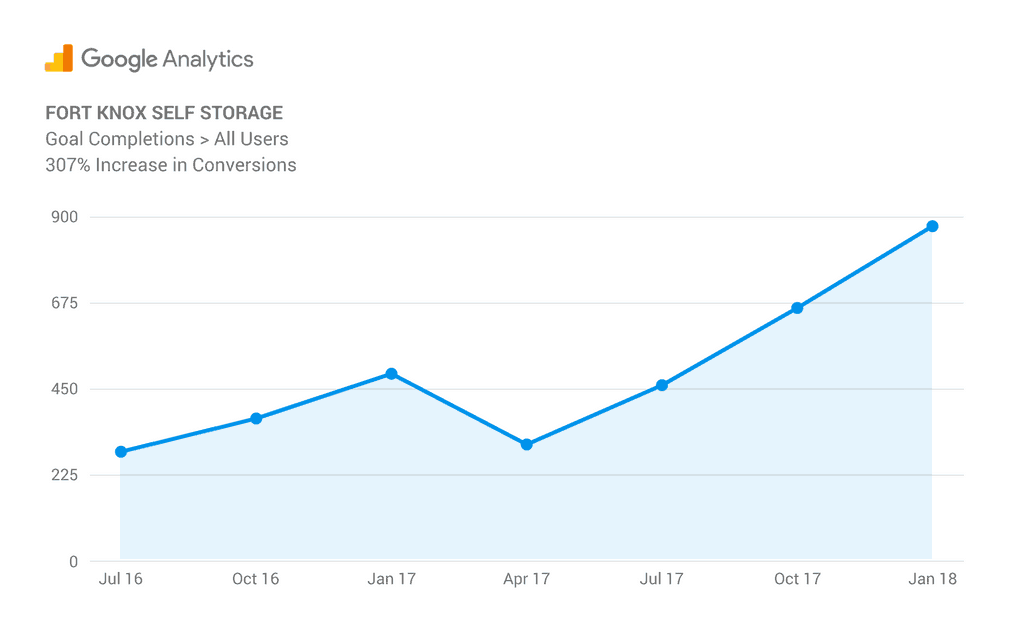
Fort Knox is a client we got 25% growth for within the first four months. Then 18 months later we've tripled the results they're receiving online.
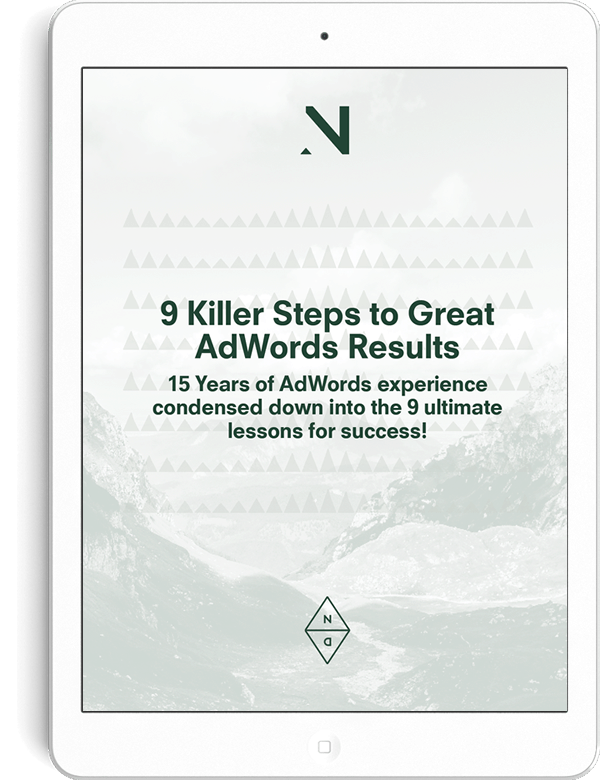
Download this post as an ebook!
It’s filled with rock solid content!
Phase 1: 20-50% growth in results in 1-3 months
Phase 1 is about giving us the quickest, biggest bang for our buck with quick, great, gains.
From our PPC Management, we have found that for over 90% of Google Ads campaigns, there is real opportunity to grow results rapidly by 20% to 50% growth within one month, maybe two or three without spending any more money. By following these tasks, you should start to see some amazing results relatively quickly and easily.
- Bid Management: more of the right visitors with less budget
- Budget management and structure: maximise conversions
- Search Query Analysis (especially negatives): more of the right visitors, and less of the crap!
Task 1: Bid Management
Aim: Capture largest amount of high intent visitors for the lowest cost
The first, quickest and easiest strategy is simply bid management (or sometimes referred to as bid optimisation) to raise or lower bids on keywords to get the most out of your budget. It is by far the most underused process to drive revenue growth quickly. It’s all about maximising your budget with smarter bidding on your keywords.
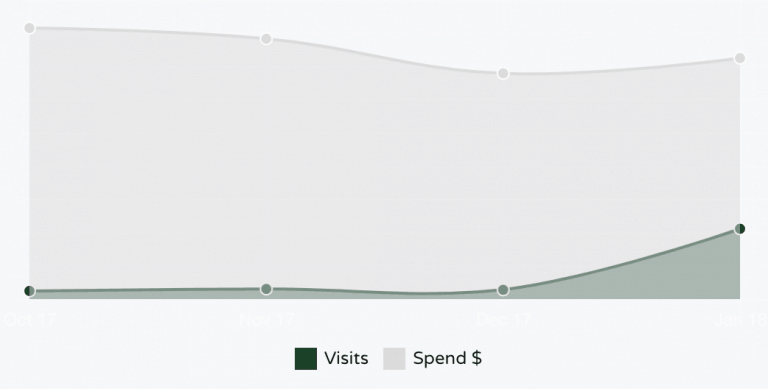
Client: gobox – Google Ads Spend and Visits the last 4 months
Bid management frequency:
- Should be done daily in the short term (2-6 weeks till campaign settles down)
- Minimum of weekly longer term
- This is all about aiming for better position in comparison to competitors
Bid management strategy:
There needs to be some reasoning behind what position you’re aiming for and why. As a general rule:
- Your brand campaigns, we’re going to aim for position 1.5
- Your competitor campaigns, average position of 2
- Keywords and campaigns that you’ve got a strong competitive advantage on, we want to aim for position 2 to 2.5
- General keywords we’re going to aim for position 2.7 – 3
This is all about ensuring that we capture the highest number of visitors for the lowest cost. If our general keywords are in position 1 or 2, we’re generally paying too much for each visitor and pissing money up against a wall (but making Google rich). Equivalently, if we’re in position 4, 5, and 6, we’re not being seen enough, so we’re not going to get enough visitors through.
For us around general keywords, we find that position 2.7-3 is a really good sweet spot because it gives us excellent volume and visitors for a really good price. That’s what we want to aim for in the short term. Longer term you can play around a bit with that to see which is going to generate the most conversions, but there are some guiding principles that you should be able to get some really good growth from really quickly, just by simply increasing and decreasing bids – it’s a fine balance of not paying too much but maximising visitors and traffic.
 Outcome:
Outcome:
Highest volume of high intent/highest converting visitors for the cheapest cost. Task 2: Budget Management and Structure
Aim: Rapidly increase conversions by giving more budget to components that are converting better
The second core concept to give you some really quick wins is better budget management. It’s really saying you know what parts of our campaign are converting well, so let’s give that more money, versus what parts of our campaign aren’t converting well, let’s take money away from this to give to the needy!
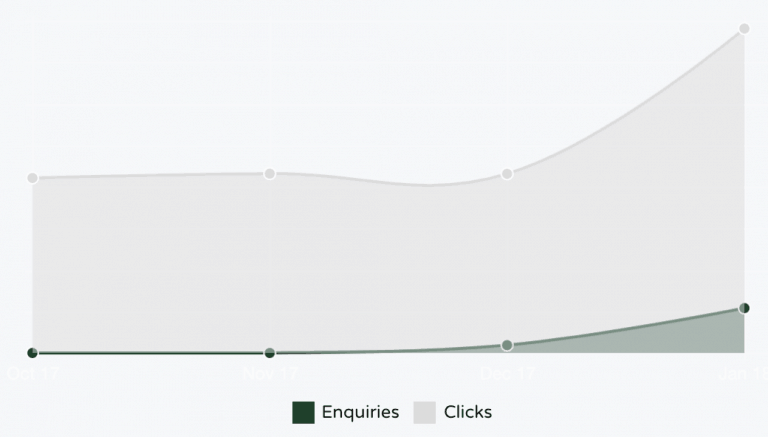
Client: gobox – 30% growth in enquiries in just 28 days
We achieved these results with the exact same keywords, exact same landing page and website, simply by shifting ad spend to areas of the campaign that were already converting.
You’ll probably need to restructure your campaigns
To manage your budgets, this can only be done at a campaign level. So, you need to create new campaigns of all the keywords and ad groups that are converting well. So that they are more split out. This will create more campaigns to manage, but it also means that you want to pull out the high converting components of a campaign and put them into its own campaign so that you can manage the budget for that.
Budget strategy and frequency
A section of your account is converting really well, so let’s give that more budget. We want to do that once again via budget management. We recommend you do budget management once a week so you’re shifting money from one campaign that’s not converting as well to another campaign that’s converting better.

Client: gobox – 40% budget lost impression share
Bear in mind lost impression share due to budget
You want to bear in mind here that you will probably notice search impression lost by budget. This is just telling you how quickly your ads are turning off each day relative to the budget that you set. If you set a budget of $50 per day, and your campaign has only got a 66.6% by budget lost, that means you’ve got another 33% growth that you can add in. You want to increase your budget on that campaign to $75, providing it’s converting well. Once again, this is all about how you shift money to converting parts of the campaign.
 Outcome:
Outcome:
Rapidly increase conversions by giving more budget to components that are converting better. Task 3: Cut Costs with Search Query Analysis and Negatives
Aim: Stop crappy visitors clicking on your ads (i.e. stop wasting money with the wrong visitors!)
The third focus to get things cranking is what we refer to as the “negatives” process, or the “search query analysis” component. We generally see between 5% and 10% growth alone in just doing this process, and there’s a couple of hours’ worth of work to get this done. What you actually do is you pull a report for the last 90 or 120, 150 days of the actual search queries that people have typed into Mr Google for your ad to display, sort them from most visitors to least visitors, and you want to run your eyes down them to see what keywords are relevant to your business and what isn’t. Once again, there will be a minimum of 5% to 10% of search queries that you’re paying for that just aren’t relevant to your business.
We saved gobox $6000 per year with 1 hour of work! Simply by reviewing the search query analysis and seeing that approx. 10% of visitors weren't relevant to them we were able to save 10% of their ad spend.
SQA and Negatives Frequency
In the first instance for a new campaign we strongly recommend doing this as a weekly process, so you get on top of this quickly. For campaigns that have been going for a while, you can do this monthly, but definitely do it regularly because once again you’ll get a 5% or 10% reduction of costs alone just from this process in the short term (and this will naturally compound longer term).
Secondly, with the search query analysis it can actually give you some ideas of keywords that you’re missing, so you can add them to the campaign to make sure you’re covering all bases.
With great power, comes great responsibility
Longer term, this process can highlight some great opportunities for you in terms of how you grow your business. For example, a client of ours in the education sector created a new course based on high search volumes for similar courses to their existing course (but not quite the same). This will be rolled out shortly and is likely to do really well knowing that there is a demand for it already. Search query analysis is a really good eye opener for how you grow and identify opportunities in your business.
 Outcome:
Outcome:
Reduced costs on visitors that aren’t looking for your specific product or service. That's phase 1 complete! 20-50% growth done!
That’s the really quick wins. As I said, with smart PPC management best guess would be from 20-50% you can get in four, six, eight weeks on better results from Google Ads – both in terms of more revenue through the door, more outcomes to your business, and also maximising costs and minimising those costs through outcomes.
Phase 2: 3-5% growth month on month, year on year
Phase 2 is about long-term requirements for ongoing growth.
To optimise performance we need to be using the data and information gathered in phase 1, to get better and better and better. We’ve outlined above just how you can get amazing results, but first, don’t stop doing phase 1!! Whatever you do, don’t stop doing bid management, budget management and SQA’s/negatives. Do that for the rest of your businesses life!
“I love working with Ben and his team. They are a no-nonsense, ‘get it done’, company. If you want to grow your business, I’d choose Due North (formerly Merchantlink) any day of the week.”
Mark Pearce
Task 4: Site Engagement Optimisation
Aim: More visitors that engage well with your website, and less visitors that don’t engage
Site engagement optimisation involves determining which keywords are generating a good visitor that engages with my website versus a bad visitor. By good visitor, we mean:
- they’re spending more time on our site,
- they’ve got a low bounce rate, and
- they’re looking at more pages.
It is really valuable to see which keywords or parts of the campaign are performing good for us and our target audience likes us, versus other parts of the campaign that aren’t good for us and the target audience clearly doesn’t like us. We want to do more of getting the right visitors to our site, and then we need to fix what’s not working for it. This is where landing page optimisation and the website overall become really important.
The landing page is vital!
First port of call in determining which factors aren’t working is the landing page. A good landing page is attractive, is representative of your brand, has strong and obvious sales propositions, has strong call to actions, has the right social proof, and basically convinces me there are good enough reasons to choose you over your competitors.
You need a sh^t hot website!
This is by far the best investment you can ever make. Your website has to be truly representative of your brand and your brand personality. Treat your website homepage and landing page like a shop window. It needs to – in 3 seconds – give users a taste of what they’re going to find inside – what products/services, what style, what price range etc. You will need to invest in it ($20-50k depending on the nature of your business) but it’s worth its weight in gold. If you go cheap, then your potential customers will be able to tell, and if the quality is not what they’re looking for, then they’re going to look elsewhere.
What is site engagement optimisation?
Site engagement optimisation is the process of optimising based on those users that engage well with your website versus those that don’t. To do this we analyse data from Google Analytics by keyword, ad group and campaign, together with the site engagement data, to create a picture of what parts of your campaign are delivering higher intent users.
Analysis of site engagement
To analyse site engagement, we sort the data by all the highest visitors first to last in order to identify those that get 60%, 70%, 80% bounce rate out of the top 20 keywords, so that we can start to get a feel for which ones aren’t performing. You will want to pull this data every month, (i.e. the last 90 days) to identify the good and the bad performing components, and build a process to fix the bad or get rid of them altogether.
 Outcome:
Outcome:
More high intent visitors that engage well with your site and increased conversion rates. Task 5: Conversion optimisation
Aim: Simply to get more leads and sales!
Conversion optimisation is a monthly process of analysing all the data by keyword, by ad group, and by campaign. We start with:
- What’s converting well and below our cost per conversion target
- What’s converting not so well above our cost per conversion target
- Assigning more budget to those that are converting well
- Reduce budget for those that aren’t converting
- A plan for how to fix and improve everything above
Don’t forget: Bid and budget management is a fundamental part of conversion optimisation, so make sure you’re still doing it!
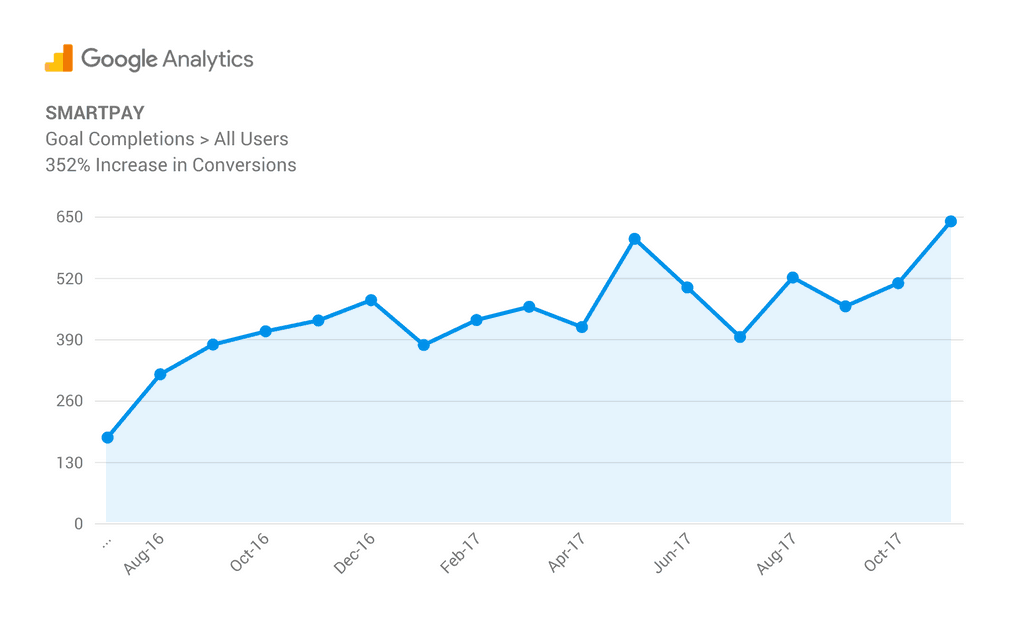
Client: Smartpay – Doubled sales in 18 months
Smartpay doubled sales within two years going through this conversion optimisation process. That is, ensuring they’ve got the right information that allows you to go through the right improvement process.
Procedure for conversion rate optimisation:
Our first protocol is to pull the reports from Google Analytics for the last 180 days to show site engagement data and conversion data by campaign, keyword and ad group. We want to be looking at:
- Which keywords are converting well with good cost per conversion and conversion rate (green)
- Keywords we should be giving more budget to (in green below)
- Which keywords we should be further explored (In red below)
Ongoing, you will want to do this monthly by last 90 days of data, so you’ve got a rolling 90 days, and you can see the improvements that are coming through. This allows you to identify any areas that aren’t working and work on a plan to fix them.
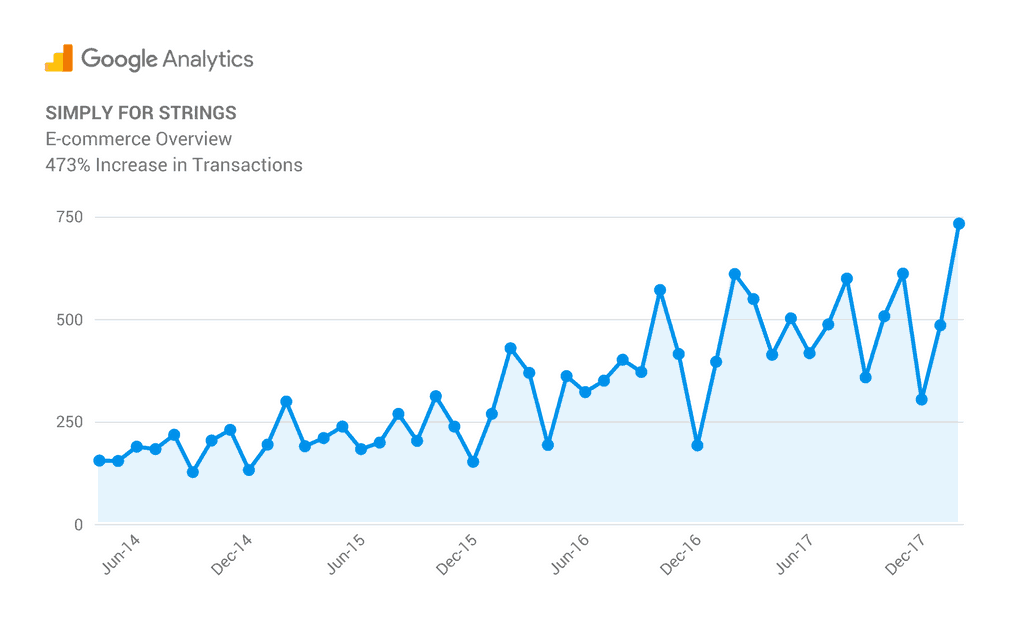
Client: Simply for Strings – 450% growth!
By doing this process for over 3 years our client’s revenue grew by 450% over that four years.
 Outcome:
Outcome:
More leads/revenue at a cheaper cost per lead/revenue. Task 6: The Right Tracking and Reporting
Tracking, reporting, analysis, recommendations and analytics are essential ingredients required to really grow your marketing channels, especially for small business owners. Google Ads for a lot of businesses is a major cost, so smart PPC management requires getting this right as soon as we can, so that we can clearly identify what outcomes we are getting.
A variable cost revenue channel
The beauty of Google Ads is that you can manage and grow your campaigns based on a variable cost model to your business so that it guarantees the returns you want. It takes a bit of time to get there, but what we want to aim for is a model whereby you spend $10, you make $100, you spend $100, you make $1,000 and on it goes. You can’t do this however unless you have the right tracking and reporting in place.
Let’s get started with me asking you a question. Say you spent $5K on Google Ads last month, can you tell me how much revenue was generated from it?
Simple question that you should be able to answer. Unfortunately, 98% of businesses can’t. And so, this task is all about being able to not only get the answers but also make sure we know what revenue each and every keyword is generating for your business.
We start by establishing tracking using an inverted sales funnel to establish tracking for:
- Outcomes: Revenue / sales / database
- Leads: Enquiries / contacts / website visitors
- Engagement: Impressions and reach
- Lead Source: Website, referral, word of mouth, paper advertising, yellow pages (really? who uses yellow pages anymore?)
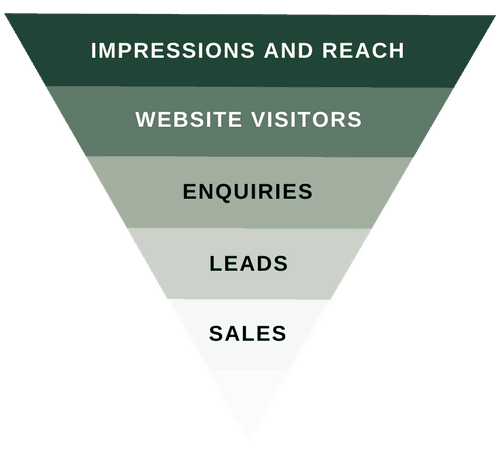
Outcomes: It’s all about the $
Your outcomes are your revenue. The factors you want to take into consideration are:
- your online sales;
- strategies to push visitors into your store;
- your sales process to convert phone leads;
- strategies to build your database (eg enquiries, sales, email sign ups).
Your database is a really valuable long-term asset to your business, so while we want to be tracking and measuring how we’re building that, we also want to be maximising the database through lead nurture and ongoing sales.
Leads: Lead source for every customer
In order to track the lifetime value of customers, every customer in your back-end database (CRM or POS) should have a lead source, tracking right back to the specific keyword that they used when searching for your products/services. This way we can see what keywords are driving revenue and which aren’t.
Engagement: Working backwards to your website
We use Google Analytics to track site engagement such as bounce rate, behaviour and time on site. Technology now allows us to track where a visitor comes from to your site and then we can push this information into your CRM/POS when they make an enquiry or purchase online. So we can say that this keyword from Google Ads generated $22,506 in revenue, or 23 enquiries (both online and on the phone), this email campaign generated $x and this social post generated 4 leads. Great data to have!
Then working backwards still to Google Ads
When it comes to Google Ads, with the right tracking we can integrate all your elements to get a complete picture. For example, $10 spent on one keyword generates $422 in revenue versus $10,000 spent on that keyword generated no revenue. This information is invaluable and will save you loads of money in the long term!
Weekly high-level reports
Depending on a few things we’d recommend just doing a high level weekly report that gets automated and sent to your inbox on Monday morning, outlining the top 5-8 metrics and KPIs you want to see. This may include total visitors, Google Ads visitors, cost per Google Ads, cost per enquiry, number of enquiries, revenue generated, or whatever those high level things are that you want to keep an eye on. This is all about identifying quickly when we’ve got any major issues or any bumper weeks, so we can once again adjust the business accordingly.
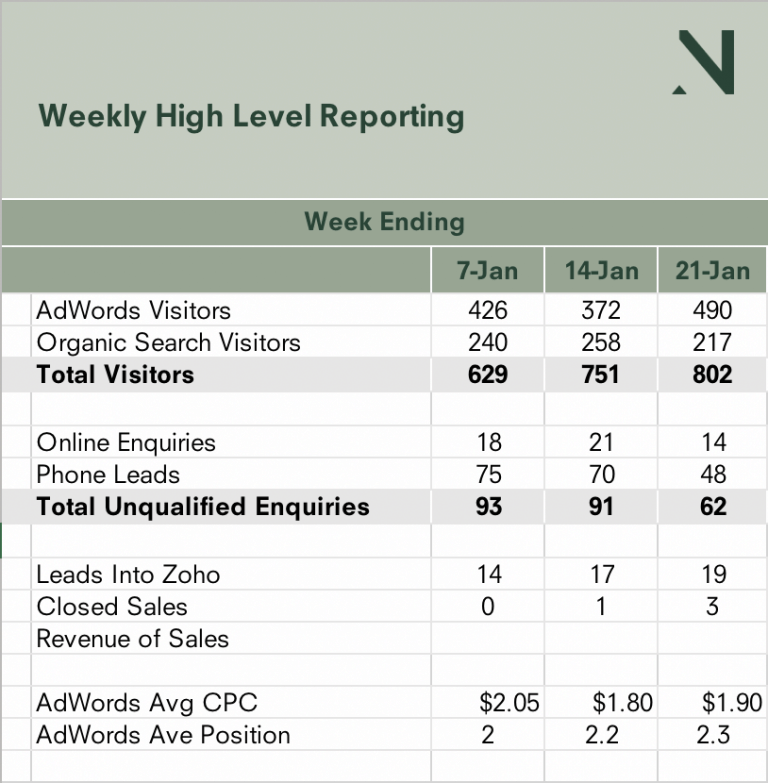
Client Weekly High Level Report Summary
Detailed monthly reports
Detailed monthly reports should go into the detail – the positives and the negatives – as well as outcomes generated for your business, including things like revenue, visitors and conversion rates.
Quarterly analysis and tactical plan of attack
This is a quarterly strategic and operational plan of attack. Did we achieve our targets/objectives last quarter, what worked well, what didn’t, what do we still need to do to complete last quarter’s tasks and objectives?. Then what are we going to achieve over the next three months and breaking this down into a tactical plan of attack of who is going to do what, and by when. Then putting this into our monthly and weekly WIPs.
 Hot Tip!
Hot Tip!
For a service-based business or a B2B-based business, inbound phone tracking is a must. It basically allows us to track every single inbound phone enquiry and where it came from; so from a digital perspective we can now say that this keyword generated this many phone calls, or this keyword generated no phone calls. We can really get granular on what’s working and what’s not working for your business.
Inbound phone tracking also has the ability to record the conversation, so from a staff training and management perspective you can then actually use that information to help get better and better at what you do. It integrates with most CRMs so that the phone call automatically populates into the CRM, and automatically creates a new lead as required as well, saving time and ensuring that every single lead and enquiry gets tracked and recorded. For the cost of a normal 1-300 number, it is well worth it considering the benefits of being able to close the tracking gap.
Task 7: Metrics!!!
Aim: Define the rules to the game of how to make Google Ads generate more money than you can dream of.
Metrics helps put the numbers behind the campaigns. It allows you to identify the financial return you need, and how you’re going to manage these campaigns financially. You want to make sure that it is a profitable campaign each and every time and set the margins that we need to do this.
Here is a sample for you:
- Lifetime value/revenue of a client: $1,000
- Cost per acquisition: 20% (500% ROI, I spend $20 on marketing, I make $100) = $200
- Conversion rate of leads to sales: 25%
- Cost per lead: $50 (25% of $200)
- Cost per visitor metric: $5 (website converting at approx. 10%*$50)
How much am I prepared to pay to acquire a new customer?
What are my marketing costs for a new sale? As a general rule, it’s approximately 10-30%. This basically assumes that if you spend $20 on marketing to get a new customer, you’ll make $100 in revenue from that customer, so you’re happy to pay 20% cost to actually acquire that customer to bring it on-board. If you have an average sale price of $,1000, then you’re happy to pay $200 to acquire that customer, which is a 500% return on your money.
How much am I prepared to pay to get that lead?
The next step from there is how much are you prepared to get that lead, or if you’re an eCommerce business to get that sale. This is a really important question when it comes to managing an Google Ads campaign because you want to manage the whole campaign based on cost per lead, which is cost per outcome to your business.
Let’s work through an example with the lead equation. Say I’m prepared to pay $200 to get a customer and my salespeople are converting one in four leads. This means that I need four leads to get one sale, therefore I’m happy to pay $50 per lead.
Get me as many leads as you can at $50 per lead!
Now we know what our cost per lead is, we’ll take as many leads as we can get at $50 per lead providing the quality is as good if not better than what we are currently getting (so that we maintain internal conversion rates of leads to sales. That’s then where the budget management and bid and campaign structure becomes really important to make sure we can do that.
Remember my note before: Keep doing phase 1 forever! By doing phase 1 above, it means we can have unlimited budgets because we are generating leads at $50 each!
How well does my website convert a visitor into a potential customer?
The final piece to the puzzle. How well your website converts a visitor into a lead or a sale. Let’s work through an example for a lead based business. Let’s say your website is converting at 10%, then we would be happy to pay $5 per visitor, which is $50 for a lead.
And now we’re back to bid management from phase 1!
Now that we’ve determined that we are happy to pay $5 per visitor, any Google Ads keywords that we’re paying more for (eg $7, $8, $9) we need to bring the bids down. Any keywords we’re paying less for (eg $2 or $3), let’s maximise and milk it as much as we can. We could even try increasing the bids a little bit to get more and more leads through the door.
You’ve created the rules to the game!
All of a sudden you’ve created the rules to the game effectively. Right?
To recap:
- This is how much we’re prepared to pay to get a new customer,
- This is how much we’re prepared to pay to get a new lead, and
- This is how much we’re prepared to pay to get a visitor to our site…
Because they will then convert into sales/revenue at the financial requirements we need them.
How to get more leads/sales?
Working with $50 cost per lead, any part of the campaign that’s converting at more than $50 we need to start back at the costs or improve the conversion rates. Similarly, if it’s converting at $20 per lead, we want more of them. Man, we’ll take as many as we can, so let’s maximise that component of the budget by putting it in its own campaign so that once again we can then manage the budget to that. This theory should also be applied to cost per visitor by increasing bids and decreasing bids.
Task 8: Integrate Your Software and Systems
Aim: Complete picture of your revenue generation capabilities.
Technology today is what allows us to get a complete picture of a businesses’ revenue generation capabilities. It allows us to integrate all of our systems and with the right tracking in place, produce reports that give us the information needed to make decisions to grow the business.
You can now know exactly how much revenue each individual keyword generates for your business
Now that you can integrate Google Ads with Google Analytics and Google Ads with your website, you can track each keyword so that it gets inserted directly into your database. This allows you to know that Jim Bob generated $2,500 in revenue and he came to this sale from this exact keyword in Google Ads.
Determining lifetime value is really important
One of the main goals of a business is to increase the lifetime value of each customer. To do this it’s really important to know the lifetime value of each customer so that you can aim to increase this over time, so that today the average client’s worth $2,000, but in six months we want it to be $2,500, and in a year we want it to be $3000. This is how you grow the revenue of your business.
It’s all about integrating your systems and software!
 Outcome:
Outcome:
Complete picture of your revenue generation capabilities. Phase 3: Strategy for long term business growth
Phase 3 is about long term growth.
Strategy is the process of defining your plan to connect with your target audience and communicate your value proposition in a way that makes them want to do business with you. We’ve broken it into two sections:
If you’re serious about wanting to scale your business, before we get started we’ve got some rules for you.
Rule 1: Do phase 1 every day and every week!
Rule 2: Do Phase 2 every week and every month!
Rule 3: Do phase 1 and 2 forever!
Rule 4: Don’t forget Rule 3 above!
Task 9: Marketing Strategy
Aim: Designing and building the path of least resistance.
As much as you might dislike the way in which the word strategy is bandied about (overused and overrated in our opinion), what it stands for is spot on. Strategy is the plan that details where you’re at today, where you want to be in 6-12 months, and the best path to get you there in the cheapest, quickest, easiest route, without skimping on quality. That’s why strategy is important. Once we’ve got some great runs on the board, we’ve got the right management in place, then we can turn our attention to how do we actually grow this longer term with the right strategy.

“Due North and Ben were able to assist us in simplifying our value proposition as well as helping us to clearly identify the value we provide clients. This has allowed us to re-position what we do and focus our energies on the valued added tasks.”
Chris Collard
Strategy is all about: Who are we selling what to
This is a really important proposition to get right because that then allows us to evolve your Google Ads campaign to be strategic, to be the right focus for you, the right messages, the right journey. Successful PPC management requires you to get crystal clear on that target audience and who they are (there will almost always be 3-6 segments) and then how do we want to use Google Ads to make sure that we’re capturing that right target audience.
Who: Clearly defined target audience groups (the more and more specific the better)
What: What value are you providing to them, what are they ‘hiring’ you to do
Once we’ve defined the target audience, we need to determine what all the possible search term combinations are that users are searching for in Google and what information they’re looking for. That requires in-depth keyword research to identify every possible topic that your target audience is searching for.
Keyword research from your target audience’s perspective
A quick note about keyword research. There’s quick, shit, crappy keyword research, which 90% of people do. You could also spend a couple of hours going through it in a bit more depth, but ultimately within 5 – 12 months, you will be wanting to do a thorough in-depth keyword research analysis that will take anywhere between 10-15 hours. This requires drilling down on every single topic possible that your target audience should be searching for, and it gives us the search volume, which is basically an indication as to how many people are actually searching for these topics.
Highest intent! Most profitable keywords first
We need to format the keywords into topics and themes, and then we want to prioritise based on the high priority, high intent people that are going to convert better, versus the low priority longer term that will be nice to have, let’s have a crack later. Focusing on your competitive advantage and the core USPs we create keyword sets that will give us our biggest bang for our buck.
Grab my attention!
What’s going to help you stand out and grab the attention of your target audience? Once we’ve piqued their interest enough to click on the ad, we then need to ensure that the landing page and website messaging is just as powerful, that we have three or four things that we can communicate that will convince our the target audience that we are their perfect match.
 Outcome:
Outcome:
Now you’re on the path to generating more money from Google Ads that you can ever dream of! Time to Scale Great Heights!
Aim: Year on year growth.
This is what every small business aspires to; year on year growth. To achieve this, you’ll need to be incorporating all of the above and beyond – the optimisation process, search query analysis, bid management, budget management, conversion optimisation, landing page improvements, website improvements, and how to milk the database!
Always look for ways to talk about what you do – revisit your keyword research and add a new topic or product or new offering every quarter through Google Ads so that once again we’re reaching new audiences in new ways, thereby generating more and more revenue.
Once you start forming the right habits every day, week and month of doing the right things that produce the right results, your Google Ads will grow beyond your wildest imagination.
You will get 20% to 50% growth within the first month, two months, three months. You can double within the next 12 to 18 to 24 months. You can quadruple and quintuple over the next 3, 4, 5 years by simply following this process, and it’s not rocket science. You just need to do it and find the right people to do it with.
Some final words before we go
Have realistic expectations of PPC management
This is not a get-rich-quick scheme. This is a do the right things across every single component of your Google Ads campaigns, and it will give you the growth you need. Google Ads has become the default advertising mechanism, so if you’re not on Google Ads your competitors are, and they’re getting the clients. That’s why we want to maximise the opportunity Google Ads is producing, and effectively its real estate online.
Be transparent with payments
Make sure you are paying Google directly – this concept of an agency taking a percentage of your spend is ludicrous. They are then working for Google and themselves and not for you! Their job is to get you to spend more, not get better performance for less costs. Pay for the service you receive, not a percentage of how much you spend.
Be realistic with budgets
Google Ads is time-consuming and labour intensive (as you’ve seen above). Even the most basic campaign, to do it right, takes 8-12 hours per month for the 1st 6 months and while this can reduce over time, you’re still going to want 5-7 hours per month at an absolute minimum. Obviously the bigger more complex campaigns, the more time required to manage them correctly.

Download this post as an ebook!
It’s filled with rock solid content!
Summary of the 3 Core Phases of PPC Management (plus a bonus one)!
Keeping it simple, we want to break this process down into three phases (with a fourth thrown in for good measure!). These aren’t things that you do at different times, they can all run concurrently, but in order to get your Google Ads pumping, there are four core things that we need to do for your business.
1. Optimisation Process
The process of getting better, and better, and better, and better, and better, and better, and better, and we break that down to:
- Bid management
- Budget management
- SQA analysis (Search Query Analysis)
- Site engagement optimisation
- Conversion optimisation
2. Management of the channel
The right tracking, reporting, metrics, targets and objectives. As a business owner or a marketing manager, you already have access to this information, however what you may not have is the current framework to track every single outcome to your business. What integration pieces do we need within the business to give us all the information?
3. Strategy
The plan for to help you achieve long-term objectives. Who are you selling what to, who is your target audience, how do we make sure we engage with them and impress them, and how are we going to reach them.
4. BONUS: Customer/Sales Experience
Last but not least, the customer experience! What is your customer strategy to help you increase your conversion rate of enquiries or in-store visits? How are you actually getting them to pull their wallet out? This requires a sales process that incorporates relevant to your marketing materials, systems, training and development to help turn your sales people into sales superstars! How effectively are you nurturing leads into sales, and how effectively are we then nurturing a sale into a repeat client?
Google Ads provides a world of opportunity to help your business grow. It can exponentially grow leads and revenue, and it even supports your broader marketing efforts due to the valuable information it gathers about your target audience’s interests and behaviours. For example, by understanding the key search terms that generate sales for your business, you can use this to form the basis of your broader marketing activity, including SEO and content strategies. All it takes is the right management of your Google Ads campaign management to take your business to the next level!909 5563






